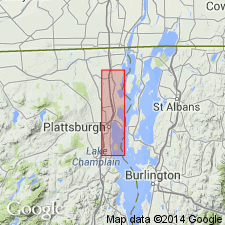
- Usage in publication:
-
- Day Point limestone
- Modifications:
-
- Original reference
- Dominant lithology:
-
- Limestone
- AAPG geologic province:
-
- Appalachian basin
- New England province
Summary:
Day Point limestone. Adopted the subdivisions of the Chazy proposed by E. Brainerd and H.M. Seely in 1888 (Amer. Geol., v. 2, p. 323-330), as explained under Chazy group, and proposed Day Point limestone for group A or lower Chazy, which is well exposed at Day Point, Peru Township, Clinton County, Champlain Valley, eastern New York. Age is Early Ordovician.
Source: US geologic names lexicon (USGS Bull. 896, p. 577).
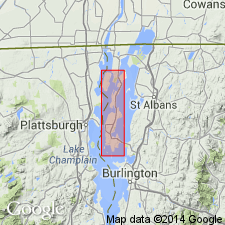
- Usage in publication:
-
- Day Point limestone
- Modifications:
-
- Areal extent
- AAPG geologic province:
-
- New England province
Summary:
Geographically extended the Day Point limestone to western VT. Overlies the Providence Island dolomite and underlies the Crown Point limestone. Thickness is 233 feet on Isle La Motte and 237.5 feet on South Hero Island.
Source: GNU records (USGS DDS-6; Reston GNULEX).
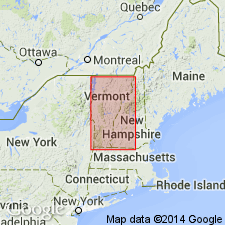
- Usage in publication:
-
- Day Point member
- Modifications:
-
- Revised
- AAPG geologic province:
-
- New England province
Summary:
Revised the Day Point to the Day Point member of the Chazy limestone in VT. Consists of calcareous quartz sandstone and calcarenite; orange-weathered dolomitic siltstones are common in eastern area. Overlies the Beekmantown group and underlies the Crown Point member of the Chazy. The Day Point is of Middle Ordovician age.
Source: GNU records (USGS DDS-6; Reston GNULEX).
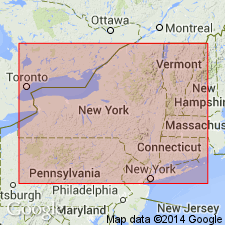
- Usage in publication:
-
- Day Point Formation
- Modifications:
-
- Revised
- AAPG geologic province:
-
- New England province
Summary:
Stratigraphy of the Middle Ordovician Day Point Formation of the Chazy Group is complex. Lateral changes in lithology produce sequences that are unique at different localities around the Champlain Valley of NY and VT. The formation comprises seven lithologies: Highly bioturbated sandstone; bioturbated, brachiopod-rich wackestone; planar cross-bedded, interlayered sandstone and sandy packstone; interlayered sandstone and shale grading into interlayered sandstone and limestone; grainstone with mound-shaped bryozoan reefs or thin, non-reefal, layers of bryozoa and planar laminated and cross-stratified beds; fine-grained calcareous sandstone with planar and herringbone cross-bedding; and planar cross-bedded packstone with bryozoan reefs or thin non-reefal layers of bryozoa. This study has revealed more sandstone units in the lower portion of the Day Point than have been previously noted. The sandstone units are followed by deeper water carbonates.
Source: GNU records (USGS DDS-6; Reston GNULEX).
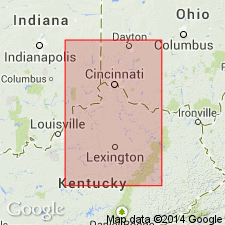
- Usage in publication:
-
- Day Point Limestone*
- Modifications:
-
- Overview
- Age modified
- AAPG geologic province:
-
- Appalachian basin
Summary:
Day Point Limestone is used in this report. Age is refined to early and middle Chazyan.
Source: GNU records (USGS DDS-6; Reston GNULEX).
For more information, please contact Nancy Stamm, Geologic Names Committee Secretary.
Asterisk (*) indicates published by U.S. Geological Survey authors.
"No current usage" (†) implies that a name has been abandoned or has fallen into disuse. Former usage and, if known, replacement name given in parentheses ( ).
Slash (/) indicates name conflicts with nomenclatural guidelines (CSN, 1933; ACSN, 1961, 1970; NACSN, 1983, 2005, 2021). May be explained within brackets ([ ]).

